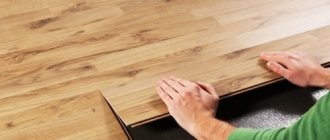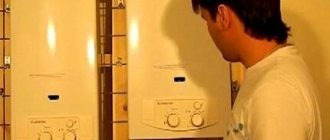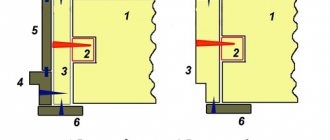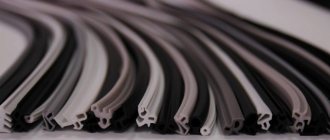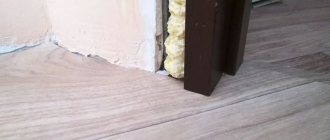Greetings, readers of my blog.
Stains from water and grease, the appearance of abrasions on the surface - all these are the reasons for the loss of the presentable appearance of interior doors. Mostly, stains appear around door handles, as well as at the bottom of the door leaf at the point of contact with the feet. The problem of dirty doors becomes especially urgent with the appearance of children or pets.
If the surface of the canvas is partially contaminated, then removing stains on the door will not be difficult. If the defects affect the entire surface, then you will have to resort to more radical methods.
Gentle ways to remove stains from doors
Every normal housewife strives to maintain order and cleanliness in the house. But some surfaces are very sensitive to cleaning and in order not to make mistakes you should follow my recommendations:
- For the manufacture of interior doors, wood is used directly or indirectly, which is resistant to high humidity. Even for simple cleaning, you should not use a very damp cloth, as this can lead to swelling of the fabric.
- To remove grease stains from the door, you should not use aggressive agents such as acetone, solvent, or alcohol.
- To remove stains, use a soft sponge for washing dishes, not wire brushes. The damaged surface of MDF or laminated doors cannot be restored - you will have to change the canvas.
Safe cleaning tools
To avoid scratching the doors when cleaning, you should use soft and lint-free fabrics, and if there are a lot of small patterns or texture on the surface, then it is better to get a brush with soft bristles.
If the surface has small scratches and cracks, beeswax will do. Deeper scratches can be filled with wax crayons - they are rubbed over the damaged area to fill the void with wax.
Knives, metal scrapers and hard sponges are not suitable for cleaning doors with any coating.
Secrets for removing stains from doors
Different door materials provide different options for removing stains from them. But there are several universal ways to restore the beauty of your door:
- in order to remove brilliant green from the door, use acetic acid
- Marks from a felt-tip pen can be washed off with white spirit or glass washing liquid.
- Some types of stains can be washed off well with vodka mixed with sunflower oil.
- Chocolate or juice stains can be easily washed off with a baby wipe
- The varnish stain can be washed off with a cotton pad slightly moistened with acetone.
- Coffee stains can be easily removed with ammonia.
As you can see, there are a lot of folk methods for removing stains from doors, but there are also professional detergents: Profoam 2000, Sif - paste, Mister Chister, Adrilan, Pronto and many others.
| Types of stains and methods for removing them from doors | ||
| Type of spot | Traditional removal method | Professional product |
| Mold | Dry the door, scrape off the mold with a scraper and treat with | |
| Egg | Mix baking soda and soap, add hot water and apply to the stain. | |
| Old dried spots | We make a mixture of salt and vegetable oil, apply it to the stain and wait for it to dry. Then carefully scrape off | |
| Fingerprints | Wet wipes or rag | Furniture cleaners |
| Scotch tape marks | Nail polish remover | Sticker Remover |
| Marks from a ballpoint pen | Profoam 2000 | |
| Plasticine | Scrape off the remains and wipe with a weak solution of alcohol in a ratio of 1 to 9. | |
| Glue or resin | Resin is removed by heating with a hairdryer | Solvent for glue |
| Varnish | Nail polish remover | |
| Urine | Laundry soap | |
| Jam | Soap + vinegar solution | |
| Wine, chocolate or juice stains | Wet wipe | |
| Pencil marks | Excellent removal with wd-40 | Profoam 2000 |
| Felt pen | Glass cleaning liquid, you can try to erase marks with an eraser | Profoam 2000 |
| Zelenka | Easily washed off with acetic acid | |
| Blood | two tablespoons of table salt + dishwashing liquid | |
| Oily stains | Acetic acid + water, wet wipes | Various cleaning products |
How to remove stains from MDF doors
For the most part, MDF doors with a veneer surface immediately after repair I strongly recommend that you open them with polish. This will protect the surface from the appearance of greasy marks and stains. But if the problem has already appeared, then it needs to be solved.
I will share with you the method that my mother advised me. It has been used since the days of the USSR, when Mister Muscle had never even been heard of :)
To restore the original appearance of MDF doors you will need the following ingredients:
- Potatoes - 1 pc.
- Dry rag
- A little baby powder
The procedure for removing grease stains from a door:
- Cut the potatoes in half and rub the stain until the juice appears
- Leave the stain for 10 minutes
- After the potato juice dries, starch will remain in place of the stain. Remove it with a dry cloth.
- If, after cleaning, white stains remain on the spot, then apply baby talc to them and wipe them thoroughly with a dry cloth.
Using this folk method, you can remove a greasy stain.
The influence of color on the choice of cleaning method
Doors in light shades (milk oak, bleached oak, etc.) are convenient because micro-scratches and dust are almost invisible on their surface. Light-colored doors are easier to clean than dark ones—there are no streaks left on their surface. For cleaning, you can use both special products and homemade compositions.
To clean a light-colored door, you can make a polish at home:
- Three teaspoons of melted granulated wax are mixed with 200 ml of vegetable oil.
- The mixture is thoroughly kneaded until a homogeneous mass is formed and left for 15 minutes to cool to room temperature.
After the polish has cooled, you can begin cleaning: apply the mixture to light-colored doors with a dry, clean cloth, rubbing the surface until perfectly smooth. This homemade composition is suitable not only for cleaning light-colored doors from greasy fingerprints and stubborn dirt, but also for polishing.
Doors of a dark color, including wenge, are more difficult to clean, but at home you can prepare a special polishing composition that will not harm the surface:
- You need to mix 1 teaspoon each of lanolin and turpentine.
- Add 4 teaspoons of soy or other vegetable oil and a few melted beeswax granules.
- The ingredients are mixed until smooth.
The mixture is rubbed into the contaminated area with a soft cloth and wiped gently.
Doors with laminated surface - cleaning methods
Thanks to the protective coating of the laminated film, these doors are easier to clean than others.
Methods for removing greasy stains from doors with a laminated surface:
- Using laundry soap
First, prepare the solution. To do this we need a bar of 72% laundry soap and warm water. We cut the soap into small pieces and prepare a solution.
We soap dirty places with a foam sponge.
Now we wash off the soap stains and wipe thoroughly, leaving no streaks on the door.
IT IS IMPORTANT TO KNOW!
The entire procedure must be done as quickly as possible to prevent water from being absorbed into the door. Otherwise, the door will swell and the laminated coating will peel off.
- Using alcohol
IT IS IMPORTANT TO KNOW!
Don't even think about using pure alcohol!
To begin removing the stain, prepare an alcohol solution. It is prepared in a ratio of 1 to 9, where 1 part is alcohol and 9 parts are water. Wet a cloth in the prepared mixture and apply it to the stain. We wait five minutes and remove the remains with a dry paper towel.
Professional products
Professional products include special formulations from the Cilit, Pronto, Mister Muscle and other well-known brands. They should be applied according to the instructions on the packaging.
Polishes (Pronto, Laska, etc.) will help get rid of fingerprints, grease stains and dirt without leaving streaks on the doors. The point is the professional composition of the polish: during cleaning the product does not penetrate inside, the wooden surface almost does not get wet and the material does not swell. Using polish, you can wash varnished wooden doors without fear of damaging the varnished coating.
There are many similar professional products designed specifically for coating care, which can be found on the shelves of supermarkets and hardware stores. It is only important to choose the right product that is suitable for a specific door covering.
Removing stains on wooden doors
Unfortunately, stains that appear on solid wooden doors require removal from the hinges of the door leaf for their subsequent removal.
Place the removed door on a flat surface, having previously unscrewed the door handles and locks.
Using a solvent, remove the old varnish from the door. Due to the fact that the solvent has a pungent odor, it is better to carry out work outdoors.
After removing the varnish, the wooden door must be sanded using a grinding machine or sandpaper. It is better to use paper with a grain size of 180/220.
Then you need to remove any remaining dust from the door. It is more convenient to use a soft, large brush.
The final stage is coating the door with a new layer of varnish.
Causes of condensation accumulation
The maximum possible moisture content in the air, or absolute humidity, depends on temperature. As the temperature rises, the absolute humidity increases, and vice versa. When a warm zone collides with a cold zone, the temperature drops and excess moisture, exceeding the level of absolute humidity, passes from a vapor state to a liquid state in the form of droplets - condensation is formed.
The temperature at which steam begins to condense is called the dew point. As relative humidity increases, that is, the percentage of moisture relative to absolute humidity, the dew point moves closer to the actual temperature and is the same as at 100 percent humidity. The intensity of condensation increases with increasing humidity in the warm zone and, accordingly, the dew point, as well as the temperature difference between the warm and cold zones. Moisture condensation continues until an acceptable decrease in relative humidity is achieved or until contact with a cold surface is removed.
For this reason, the formation of condensation is especially noticeable in winter, since in summer the temperature inside and outside is not very different. Places and surface areas in contact with the street - the front door, windows, ventilation pipes in the roof area, corner joints of walls and ceilings, cracks and loose junctions of structures - are problematic due to constant condensation. For a metal entrance door, the boundary between cold and heat, on which condensation is deposited, is the internal surface, cooled due to the presence of cold bridges (frame, stiffeners, door frame).
Another reason for the formation of condensation is oversaturation of air with water vapor, for example, in a steam room, bathroom or kitchen during long-term cooking. When over-humidified air and cold surfaces combine, the effect of double condensation occurs.
Removing grease stains from painted MDF doors
For the most part, all painted MDF doors are covered with a layer of varnish. Therefore, the use of abrasive materials and aggressive stain removal agents is unacceptable. Damage to the top varnish layer will lead to fading and loss of integrity of the protective layer.
There are two ways to clean painted doors:
- As in the case of laminated chipboard doors, we will use 72% laundry soap. It is necessary to wash the area of contamination with a strong soap solution, then thoroughly rinse off the remaining solution and wipe dry with a paper towel.
- If the first method does not help, then let's try the second. For this we need baking soda and mouthwash. By mixing them we get a “hellish mixture” that must be applied to the stain. Wait a couple of minutes and wash off the remaining stain with water. Wipe the surface dry.
IT IS IMPORTANT TO KNOW!
In order to restore the former shine to the lacquered surface of the door, simply wipe the area where the stain was removed with vegetable oil.
Alcohol-containing compounds
There is no need to use forty proof vodka. You will need medical ethyl alcohol. Of course, it is not advisable to dilute it with water, otherwise the temperature will decrease to the same vodka.
Such a remedy will have little effect. So, you need to apply a little alcohol to a cotton pad or foam sponge and wipe the plastic surfaces.
You can try ammonia. If it doesn't work, you should mix it with a small amount of hydrogen peroxide. This composition has excellent bleaching properties and does not corrode plastic.
How to clean laminated chipboard panels
There are four ways to wash stains from chipboard panels:
- Citric acid
Prepare the solution - add two tablespoons of acid to 200 ml of cold water. Mix thoroughly and wash off the stain with the resulting mixture. Wipe the treated area with a dry cloth.
- Using a solvent
A cotton pad should be moistened with solvent and carefully rinse off the greasy stain. After removal, the surface is also wiped with a clean towel.
- Detergent
Add three tablespoons of detergent to half a glass of water. Mix and apply the resulting foam to the stain. Wait 3 - 5 minutes and rinse thoroughly. Wipe dry with a clean rag.
- Baking soda
Mix three tablespoons of baking soda per glass of water. The resulting solution washes off the stain. Then the surface is wiped dry.
Why does plastic turn yellow?
In order for window frames to always remain snow-white, you need to know what causes them to turn yellow, and, as far as possible, avoid aggressive exposure to harmful factors on the plastic.
The following effects lead to the appearance of yellowness:
- weather conditions: temperature fluctuations, sunlight, high humidity;
- using products with abrasive additives to clean windows;
- washing frames with products that destroy the structure of plastic;
- plastic absorbs nicotine, soot, fat, so a yellow coating appears and the color fades;
- the surface of the frame was contaminated with plaster or foam.
Often, to reduce costs, a manufacturer uses cheap polymers that do not contain light stabilizers. Therefore, you should choose an installation company after carefully checking its reputation and studying customer reviews.



